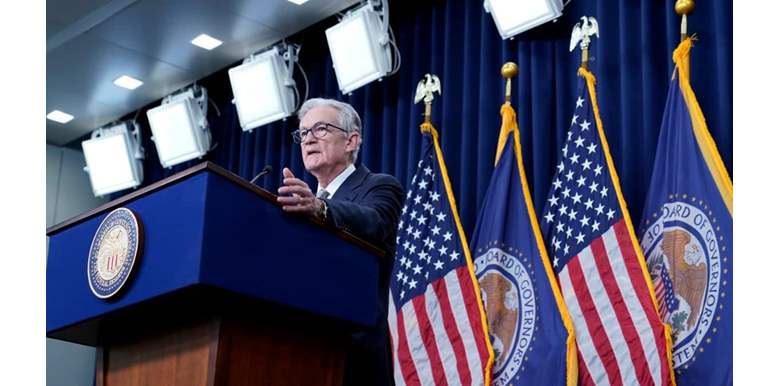Following the announcement, both stocks and bonds rallied amid hopes the Fed’s tightening cycle is coming to an end.

Federal Reserve Chair Jerome H. Powell speaks during a news conference at the Federal Reserve in Washington, Wednesday, Nov. 1, 2023. The Federal Reserve kept its key short-term interest rate unchanged Wednesday for a second straight time but left the door open to further rate hikes if inflation pressures should accelerate in the months ahead. (AP Photo/Susan Walsh).
Shifting Criteria for Interest Rate Determination
Previously, the Fed’s stance has been that it will consider a range of economic data when determining interest rates, including trends in inflation and employment. Nevertheless, the Fed’s choice to keep rates unchanged, despite a series of robust jobs reports and nearly 5 percent annualized growth in real GDP in the third quarter, indicates other factors are also being weighed.
1. Impact of Treasury Bond Yields
One factor is the spike in Treasury bond yields of a whole percentage point since the Fed last raised rates at the end of July. In a speech before the Economic Club of New York, Powell acknowledged that the spike in yields was tightening financial conditions and could lessen the need for additional Fed rate hikes “at the margin.”
2. Geopolitical Risks & Market Dynamics
Another consideration is increased geopolitical risks in the wake of the unprovoked attack on Israel by Hamas. Markets have not reacted to the provocation thus far, mainly because members of OPEC are not threatening to curb oil production as they did 50 years ago during the Yom Kippur War. The risk, however, is that the conflict could escalate throughout the Middle East depending on how Israel retaliates to the attack. If so, oil prices could surge.
In the process, the Federal Reserve has gone from being data-dependent to also being market-dependent.
Some observers believe it is a mistake for the Fed to let markets do its job in setting interest rates. James Mackintosh of the Wall Street Journal contends that the Fed is putting too much faith in the markets. He questions why bond yields have spiked when inflation has come down and short-term rates are unchanged.
The Surge in Bond Yields
The most common explanation is that the surge in bond yields reflects an increase in the term premium — the additional yield on bonds that captures all the uncertainties that investors accept in holding long-dated bonds. One possibility is investors are concerned about outsized federal budget deficits increasing the supply of government bonds while the Fed allows bonds to roll off its portfolio as they mature. However, Mackintosh finds it odd that investors have only worried about this recently.
My opinion is that it would be improper for the Fed to base its decision on interest rates solely on bond yields. Indeed, until recently, bond investors were expecting the Fed to cut interest rates this year and for yields to decline, even though the Fed consistently signaled that it intended to keep rates higher for longer.
Economic Impact if the Spike in Yields is Overlooked
Furthermore, it would also be a mistake for the Fed to ignore the spike in yields. The primary reason is they can directly impact the economy and lessen the chances for a “soft landing.” Economists at Deutsche Bank and Goldman Sachs estimate that constricted financial conditions could lower economic activity next year by 0.6-1.0 percentage points, respectively. In the Q&A after the FOMC meeting, however, Powell cautioned that the impact hinges on how persistent the tightening of monetary conditions is.
Housing Sector Vulnerability: Affordability and Market Ties
The U.S. housing sector looks particularly vulnerable now. Although residential investment turned positive in the third quarter after declining since the Fed began its policy tightening, the uptick is likely temporary. Recent indicators show homebuilder sentiment has plummeted, and housing sales are the weakest since 2010.
U.S. home prices have not cracked thus far mainly because inventories are low, and 90 percent of homes are financed with 30-year fixed-rate mortgages, according to Freddie Mac. However, with long-term mortgage rates now at 8 percent, housing affordability is the most expensive on record due to the combination of house price appreciation and rising mortgage rates. Consequently, the fate of the housing sector is now more closely tied to the bond market than to monetary policy.
More evidence that interest rates are beginning to take a toll on the economy is apparent from data from Equifax on consumer credit: This year, credit card delinquencies have hit 3.8 percent while defaults on auto loans have increased to 3.6 percent, which are the highest levels in more than 10 years.
The housing and auto sectors are significant because they traditionally are the first to weaken in response to higher interest rates. While they have held up thus far, they could still succumb, considering that monetary policy works with lags.
Considering all these uncertainties, the prudent course for the Fed is to signal its willingness to keep rates on hold for an extended period. This could help stabilize the bond market by lessening uncertainty about what it is likely to do at each FOMC meeting. With interest rates now positive in real terms, the impact of policy tightening on the economy should become more evident.
Finally, the Fed’s commitment to lower inflation is more credible today than when it began tightening policy and had to play catch up.
A version of this article was posted to TheHill.com on November 3, 2023.
This publication has been distributed for informational purposes only and should not be considered as investment advice or a recommendation of any particular security, strategy, or investment product. Opinions expressed in this commentary reflect subjective judgments of the author based on the current market conditions at the time of writing and are subject to change without notice. Information and statistics contained herein have been obtained from sources believed to reliable but are not guaranteed to be accurate or complete. Past performance is not indicative of future results.



























